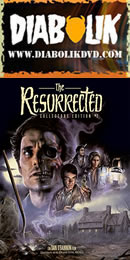
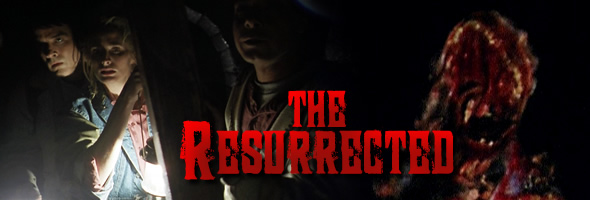
Color, 1991, 105 mins. 30 secs.
Directed by Dan O'Bannon
Starring John Terry, Jane Sibbett, Chris Sarandon, Robert Romanus
Vinegar Syndrome (UHD & Blu-ray) (US R0/RA 4K/HD), Scream Factory (Blu-ray) (US RA HD), OFDb Filmworks (Blu-ray & DVD) (Germany RB/R2 HD/PAL), Metrodome (UK R2 PAL) / WS (1.85:1) (16:9), Lionsgate (DVD) (US R1 NTSC)
It's doubtful that the 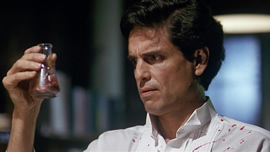 second and final directorial effort for Dan O'Bannon
second and final directorial effort for Dan O'Bannon 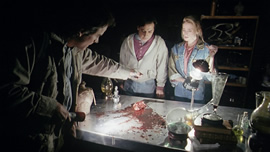 (after The Return of the Living Dead) could have come at a worse time. The theatrical market for horror in the early '90s was imploding with the majority of worthy titles shuffling off straight to VHS instead, and even once-mighty genre titans like John Carpenter were stumbling as they tried to hop into other genres. However, O'Bannon (who also wrote Dark Star, Blue Thunder, and Alien) had just collaborated on the well-received Total Recall, and so the self-professed Lovecraft fan was allowed to direct a feature film version of the horror scribe's novella, The Case of Charles Dexter Ward, which had been earlier adapted very loosely by Roger Corman as The Haunted Palace with Vincent Price. O'Bannon had been trying to crack the story himself for years but instead turned to a script by Brent Friedman (Syngenor), who had come up with a clever way of modernizing the tale while remaining faithful to the original narrative.
(after The Return of the Living Dead) could have come at a worse time. The theatrical market for horror in the early '90s was imploding with the majority of worthy titles shuffling off straight to VHS instead, and even once-mighty genre titans like John Carpenter were stumbling as they tried to hop into other genres. However, O'Bannon (who also wrote Dark Star, Blue Thunder, and Alien) had just collaborated on the well-received Total Recall, and so the self-professed Lovecraft fan was allowed to direct a feature film version of the horror scribe's novella, The Case of Charles Dexter Ward, which had been earlier adapted very loosely by Roger Corman as The Haunted Palace with Vincent Price. O'Bannon had been trying to crack the story himself for years but instead turned to a script by Brent Friedman (Syngenor), who had come up with a clever way of modernizing the tale while remaining faithful to the original narrative.
The original screenplay was oddly entitled Shatterbain (a title the IMDb still clung to tenaciously for years), while O'Bannon completed his workprint as The Ancestor before the final product was sent out as The Resurrected. Unfortunately the film was taken out of O'Bannon's hands by the producers, who brought in composer Richard Band and created a final assembly themselves just as the production company, Scotti Brothers Pictures, was completely imploding. Genre fans loved the film (and it routinely still pops up near the top of Lovecraft screen adaptations), but the 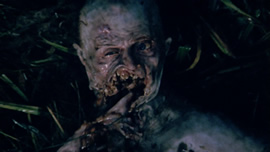 film was still given an unceremonious haul direct to
film was still given an unceremonious haul direct to 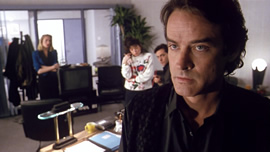 VHS by Live Home Video which later absorbed into Artisan and then Lionsgate, who only released a lackluster, now-discontinued DVD from the same old tape master.
VHS by Live Home Video which later absorbed into Artisan and then Lionsgate, who only released a lackluster, now-discontinued DVD from the same old tape master.
Our tale begins at a mental institution where something very bad and very bloody has happened, which spurs our hero, detective John March (Terry, Hawk the Slayer himself) to relate in flashback how it all went down. March is hired by Claire Ward (Sibbett) to investigate her husband, Charles (Fright Night's Sarandon), who's holed himself up in a remote family home to conduct mysterious experiments. Aided by his assistant, Lonnie (Fast Times at Ridgemont High's Romanus), March does some digging around the Ward house and interviews the locals, who warn him about the overwhelming stench of death emanating from the place. Ward himself behaves very strangely and defensively when approached, and on top of that he's obsessed with one of his more infamous ancestors, Joseph Curwen, an 18th-century alchemist whose misdeeds have become part of the dark local folklore. Now the murders and mutated experiments from Curwen's past seem to be making a comeback as March uncovers a catacomb-enclosed horror he couldn't have imagined.
Though filmmakers had avoided Lovecraft almost entirely for most of the 20th century, the writer was suddenly a hot property at the time thanks to Stuart Gordon's Re-Animator and From Beyond as well as the direct-to-video success of The Unnameable. This one manages to do it right by sticking to the pulpy, grotesque tone of Lovecraft's prose, and while some of the pacing and acting are highly erratic in the first third or so, the film really works its magic once the story picks up a full head of steam. It also wisely sticks closely to the source, retaining the central twist ignored completely in the earlier Vincent Price version and also delivering a host of gruesome monsters and other practical effects courtesy of Todd Masters Company, Inc. Despite its lack of distributor support, the film's quality shone through brightly and it managed to earn a respectable cult following even if most people had to work very, very hard to track it 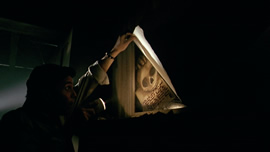 down if they missed the
down if they missed the 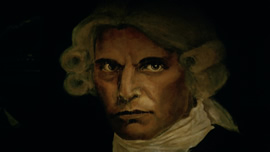 first round on VHS.
first round on VHS.
Even if you were lucky enough to dig up a copy, there wasn't a remotely respectable video presentation of this film until the 2015 mediabook Blu-ray/DVD edition from Germany courtesy of OFDb Filmworks. MGM holds the overseas rights to this film, so their HD master was used here; though not even close to demo quality for modern home theater enthusiasts, it was a massive leap up over any prior version out there. You can also clearly make out what's happening during the long catacombs sequence, which was mostly a dark, dreary mess before. Many shots in the film are treated with some kind of diffusion or partially framed behind waxy or foggy surfaces, so that complicates things even further. The audio options on the Blu-ray are German DTS-HD MA 5.1 and 2.0 along with the original English 2.0 (also DTS), along with audio commentaries by Marcus Stiglegger and Kai Naumann, Jorg Keptz and Daniel Peree from Wicked-Vision magazine, and (in the only track recorded in English) Friedman, Todd Masters, Romanus, and producers Mark Borde and Kenneth Raich. The first two German commentaries appear to be more historical and scholarly in nature (judging from yours truly's extremely limited familiarity with the language), while the third track is a very positive, dense look at the film's production from the inception of the script through the bumpy release period. Also included are English and Japanese trailers (the former looking especially rough), a gallery of promotional and making-of images, vintage footage of O'Bannon's acceptance speech at the Chainsaw Awards (incredibly enough, hosted by Bruce Campbell and presented by Quentin Tarantino), and 18 minutes of deleted and alternate footage from O'Bannon's workprint. The only essential bit of footage here is the longer, more coherent death of a minor character during the climax (whose flesh is consumed here 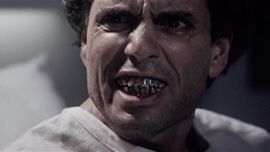 whereas he dies for no apparent reason in the theatrical cut), but some other added scenes include a (wisely
whereas he dies for no apparent reason in the theatrical cut), but some other added scenes include a (wisely 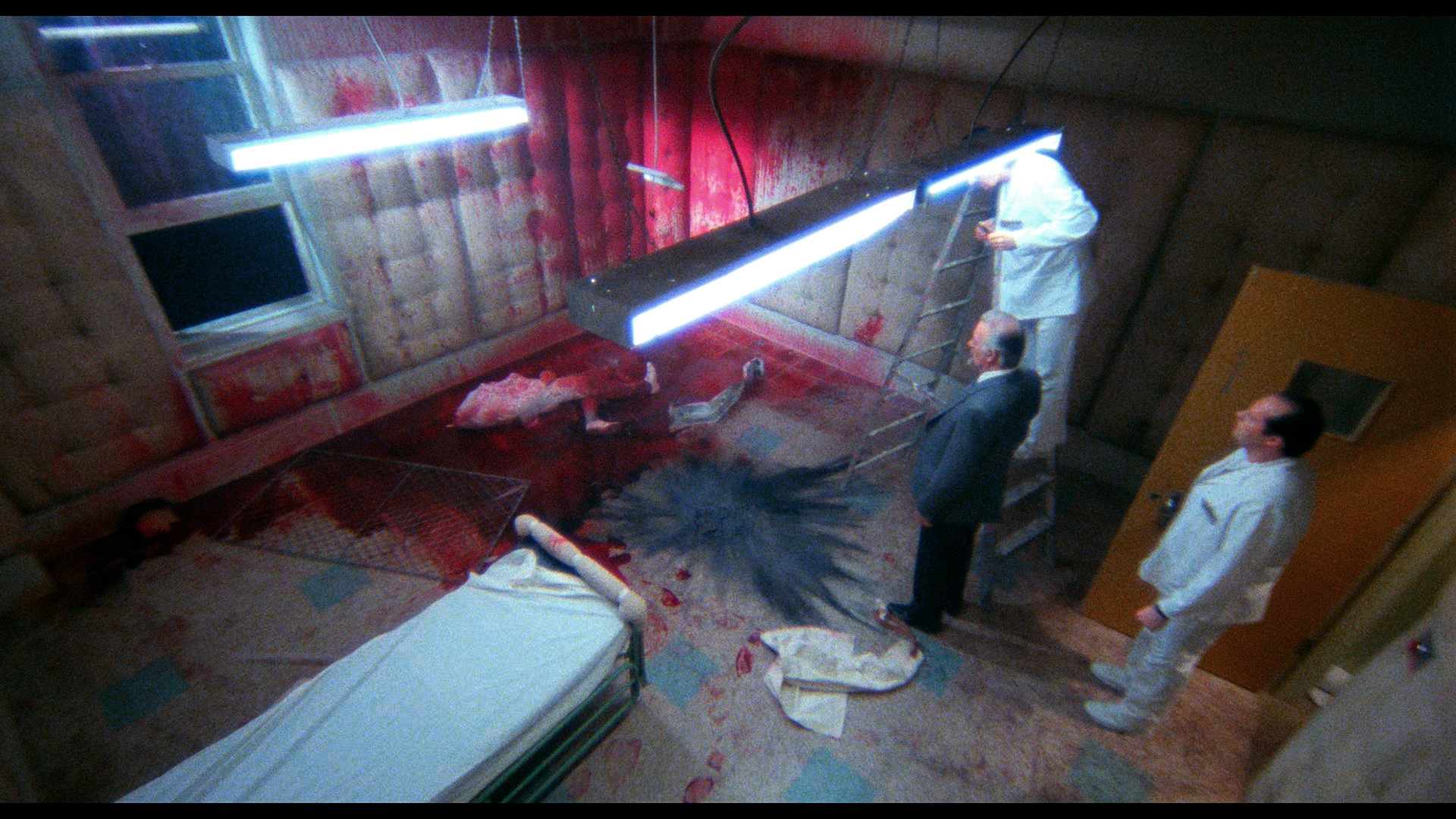 jettisoned) romantic subplot for March and Mrs. Ward and a more gruesome dream sequence with some squishy stock footage of brain surgery. What's more interesting here is reflecting how some of the more inconsequential footage would have affected the pacing and tone of the film, with Terry's performance in particular making a little more sense as he has some deadpan comic bits with Lonnie and his secretary that clarify what he was going for here. As you'd probably expect, the quality of all this footage is pretty rough (with some missing effects shots and no music score), but it's great to have it included here.
jettisoned) romantic subplot for March and Mrs. Ward and a more gruesome dream sequence with some squishy stock footage of brain surgery. What's more interesting here is reflecting how some of the more inconsequential footage would have affected the pacing and tone of the film, with Terry's performance in particular making a little more sense as he has some deadpan comic bits with Lonnie and his secretary that clarify what he was going for here. As you'd probably expect, the quality of all this footage is pretty rough (with some missing effects shots and no music score), but it's great to have it included here.
On top of that you get five new featurettes, courtesy of Red Shirt Pictures and all packed with useful material: "The Resurrected Man" with Chris Sarandon (15m34s), "Abominations & Adaptations" with screenwriter Brent Friedman (17m48s), "Grotesque Melodies" with composer Richard Band (10m14s), "Lovecraftian Landscapes" with production designer Brent Thomas (7m57s), and "Human Experiments" with special effects artist Todd Masters (15m56s). All of them have fond memories of the eccentric "gentleman" O'Bannon, who passed away in 2009 and was suffering from significant health issues at the time. Sarandon gets in some fun stories about how doing A Tale of Two Cities for TV prepped him for his dual roles here, and he also gets in some warm words about working with Tom Holland on Fright Night and Child's Play (which he refers to as his first real genre efforts, glossing over The Sentinel with one oblique but hilariously barbed mention). Friedman is a fun raconteur as well discussing how he and O'Bannon meshed their affection for Lovecraft together here, and Band has some insightful notes about his score including a fun explanation of how his catacomb music kept dropping lower and lower as the characters went deeper down themselves. Likewise, Masters and Thomas vividly recall creating the look of the film from the desolate, Lovecraftian locales and buildings to the memorably grotesque latex monstrosities, including one doozy seen in the 18th-century sequence. The packaging also features a hefty 84-page illustrated essay by Jorg Kopetz entitled "Lovecraft Resurrected: The Cosmic Catacombs Art of Dan O'Bannon," and 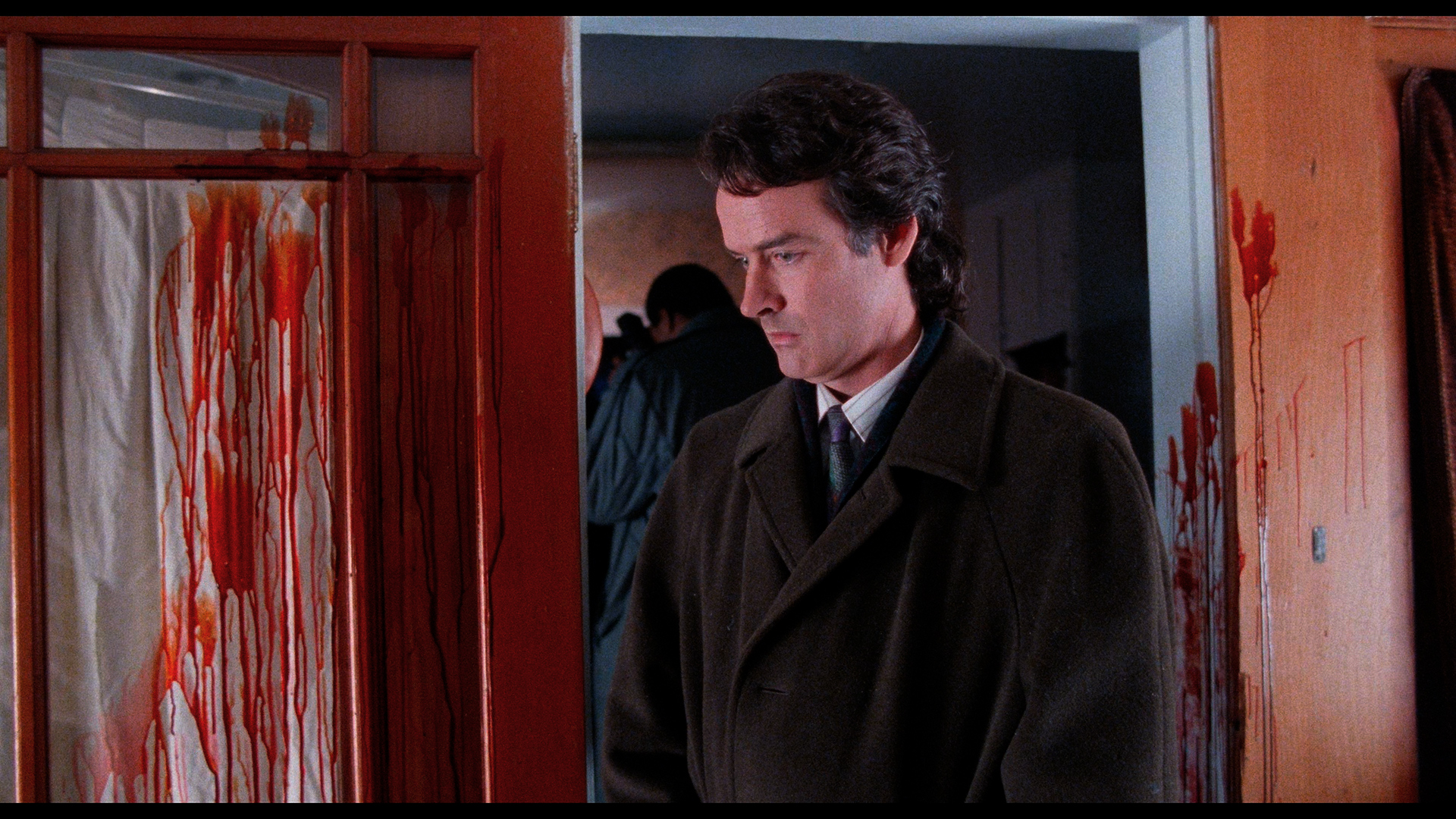 the DVD also has a two-part dramatization of the original tale.
the DVD also has a two-part dramatization of the original tale.
In 2017, Scream 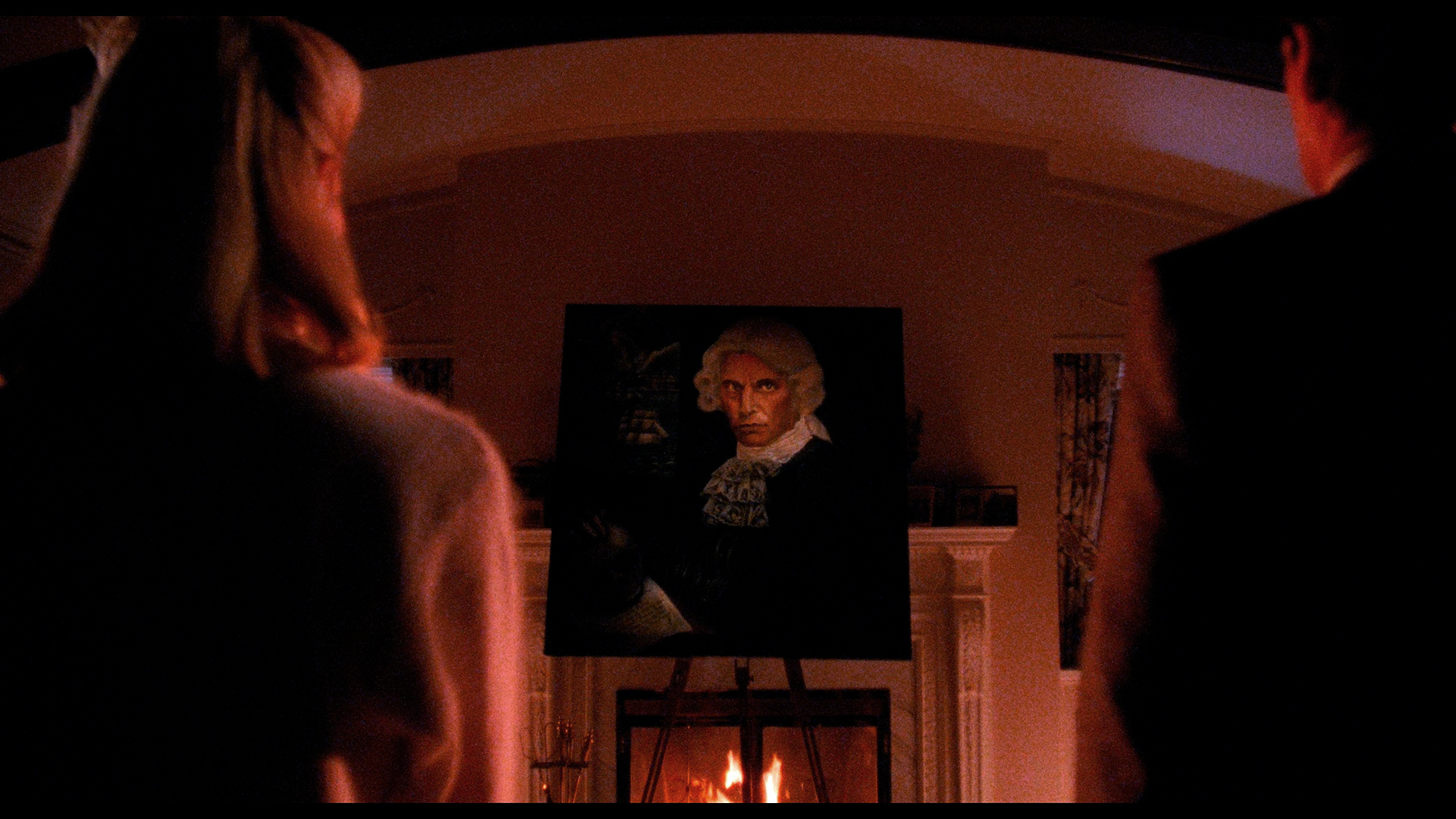 Factory brought the film back into circulation as a Blu-ray special edition that marked its first worthwhile stateside presentation. Surprisingly, it also featured a much newer and fresher-looking scan compared to the German Blu-ray with better detail and color; as usual the DTS-HD MA 2.0 English track sounds fine and features optional English SDH subtitles. Extras include the previous commentary track with Borde and company, the five Red Shirt featurettes, the deleted scenes, the Chainsaw Awards speech, the U.S. and Japanese trailers, and an 8m10s photo gallery. You also get two new featurettes starting with "Claire's Conundrum" (15m29s) with a very endearing Sibbett talking about her own trepidation when it comes to horror movies, her early acting career in TV, her thoughts on the film's enduring appeal, and the odd icebreaking moment she had with Terry for their first scene. In "The Strange Case of Charles Dexter Ward" (24m22s), author S.T. Joshi covers the essential themes of the story, the autobiographical elements Lovecraft incorporated, the role of Providence in the story, and the way the film translates the material in sometimes very clever ways.
Factory brought the film back into circulation as a Blu-ray special edition that marked its first worthwhile stateside presentation. Surprisingly, it also featured a much newer and fresher-looking scan compared to the German Blu-ray with better detail and color; as usual the DTS-HD MA 2.0 English track sounds fine and features optional English SDH subtitles. Extras include the previous commentary track with Borde and company, the five Red Shirt featurettes, the deleted scenes, the Chainsaw Awards speech, the U.S. and Japanese trailers, and an 8m10s photo gallery. You also get two new featurettes starting with "Claire's Conundrum" (15m29s) with a very endearing Sibbett talking about her own trepidation when it comes to horror movies, her early acting career in TV, her thoughts on the film's enduring appeal, and the odd icebreaking moment she had with Terry for their first scene. In "The Strange Case of Charles Dexter Ward" (24m22s), author S.T. Joshi covers the essential themes of the story, the autobiographical elements Lovecraft incorporated, the role of Providence in the story, and the way the film translates the material in sometimes very clever ways.
In 2025, Vinegar Syndrome revisited the film as a UHD and Blu-ray edition with an expanded slate of extras and a new 4K scan from the original camera negative that easily wipes the floor with its predecessors. The HDR-compatible Dolby Vision grading of the UHD in particular looks stunning with the stylized orange and blue highlights in particular really jumping off the screen, and fine detail is greatly increased with textures like foliage, hair, and clothing looking much more nuanced. The DTS-HD MA 2.0 English stereo track is good as always and comes with optional English SDH subtitles, and the Borde and company commentary is carried over as well. The Blu-ray contains all of the video extras, porting over the five Red Shirt Pictures featurettes, the two added Scream Factory featurettes, the Chainsaw Awards speech, photo gallery, U.S. and Japanese trailers, and deleted scenes. New here are a trio of featurettes starting with "Duality of Man" (20m53s) with Sarandon, which starts off recapping his introduction to Lovecraft and his role but then adds some good stuff about his approach to playing villains (comparing this to The Princess Bride), the O'Bannon connection to a Nick Castle podcast he did, and the motivation of his character(s) in this film in two different time periods. In "Being Present" (14m38s), Romanus looks back at his role, his path to acting in California initially to get over stage fright, his wholehearted approach to tackling characters, and the casting process that led him to this film including his familiarity with Lovecraft and affinity for comic dialogue. Finally in the perceptive "A Grisly Crossover" (25m42s), Kim Newman examines the film as a hardboiled Lovecraft adaptation along with the surge in the author's popularity on paperback in the '60s, the influence on later horror writers, and O'Bannon's own alignment with the writer's approach to led him to make this film after his previous forays into the undead.
Vinegar Syndrome (UHD)
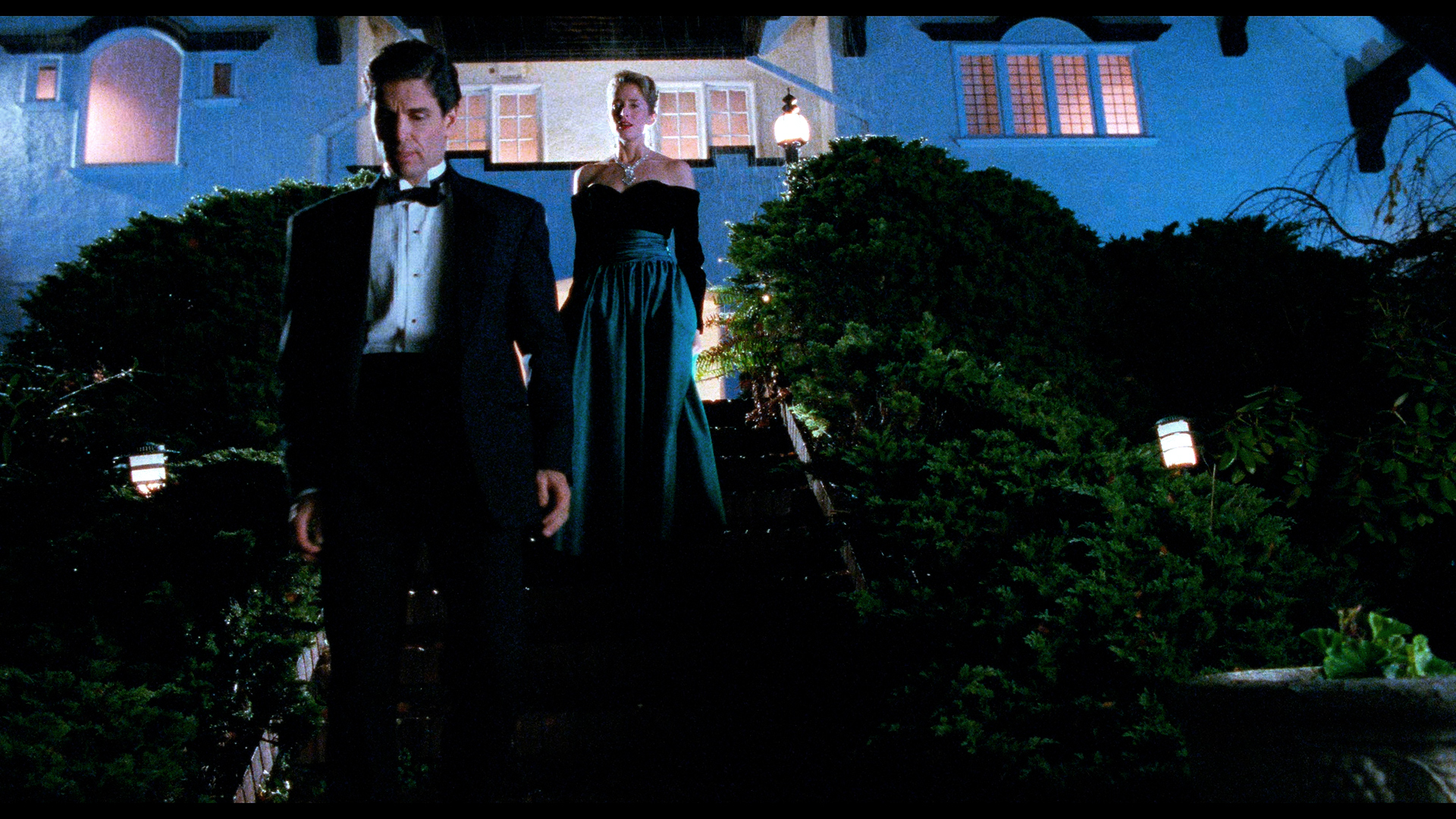
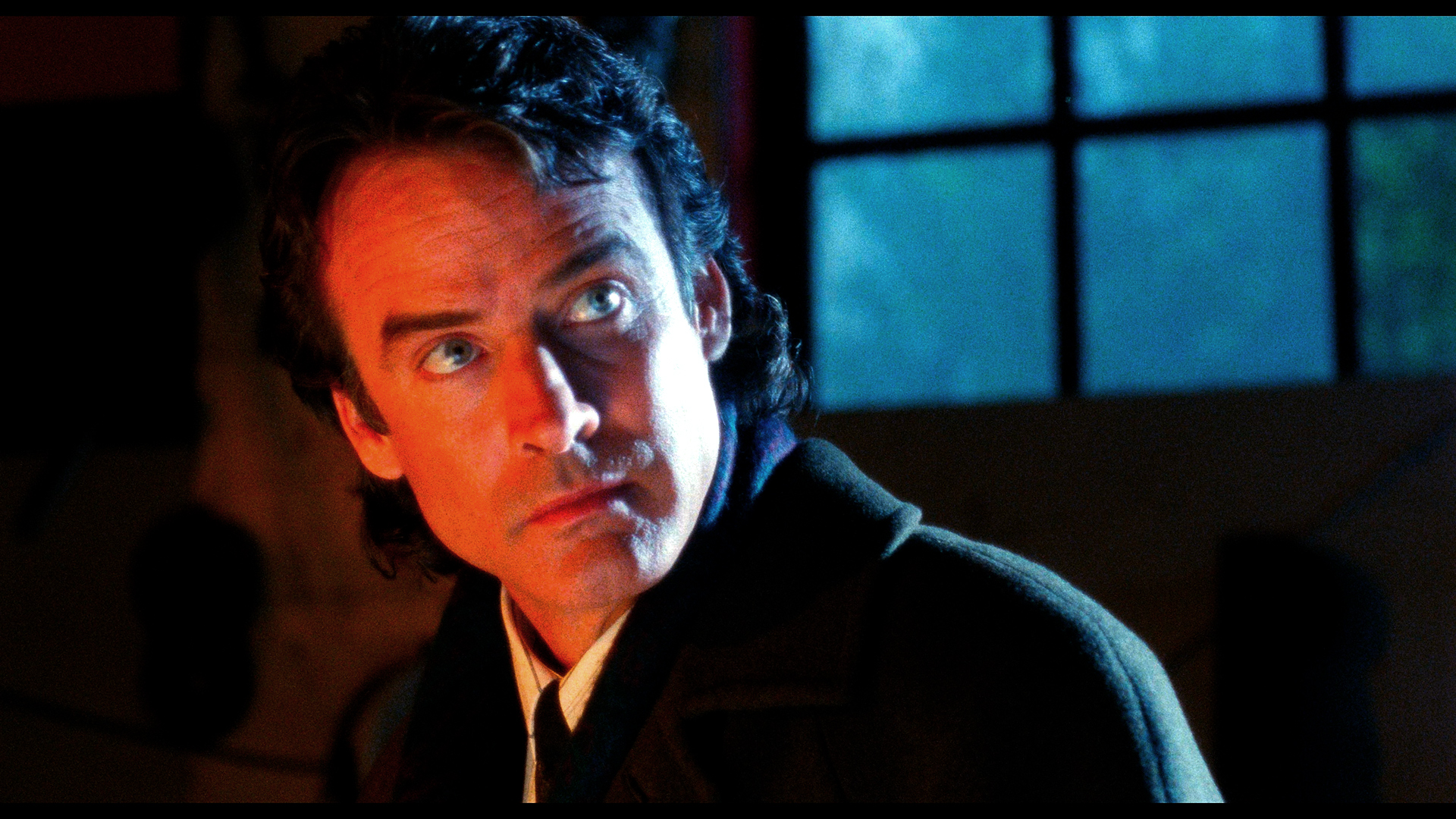
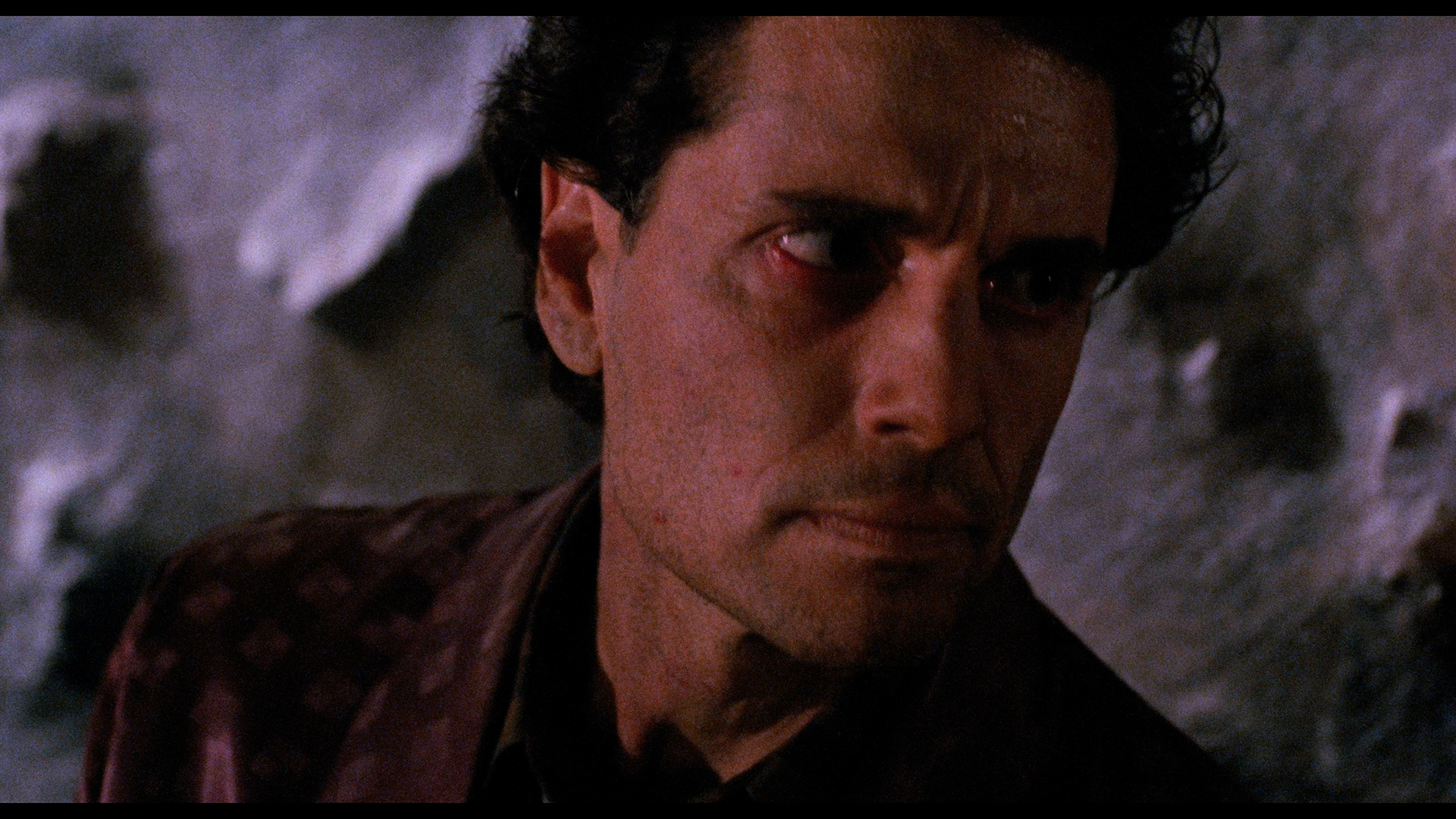
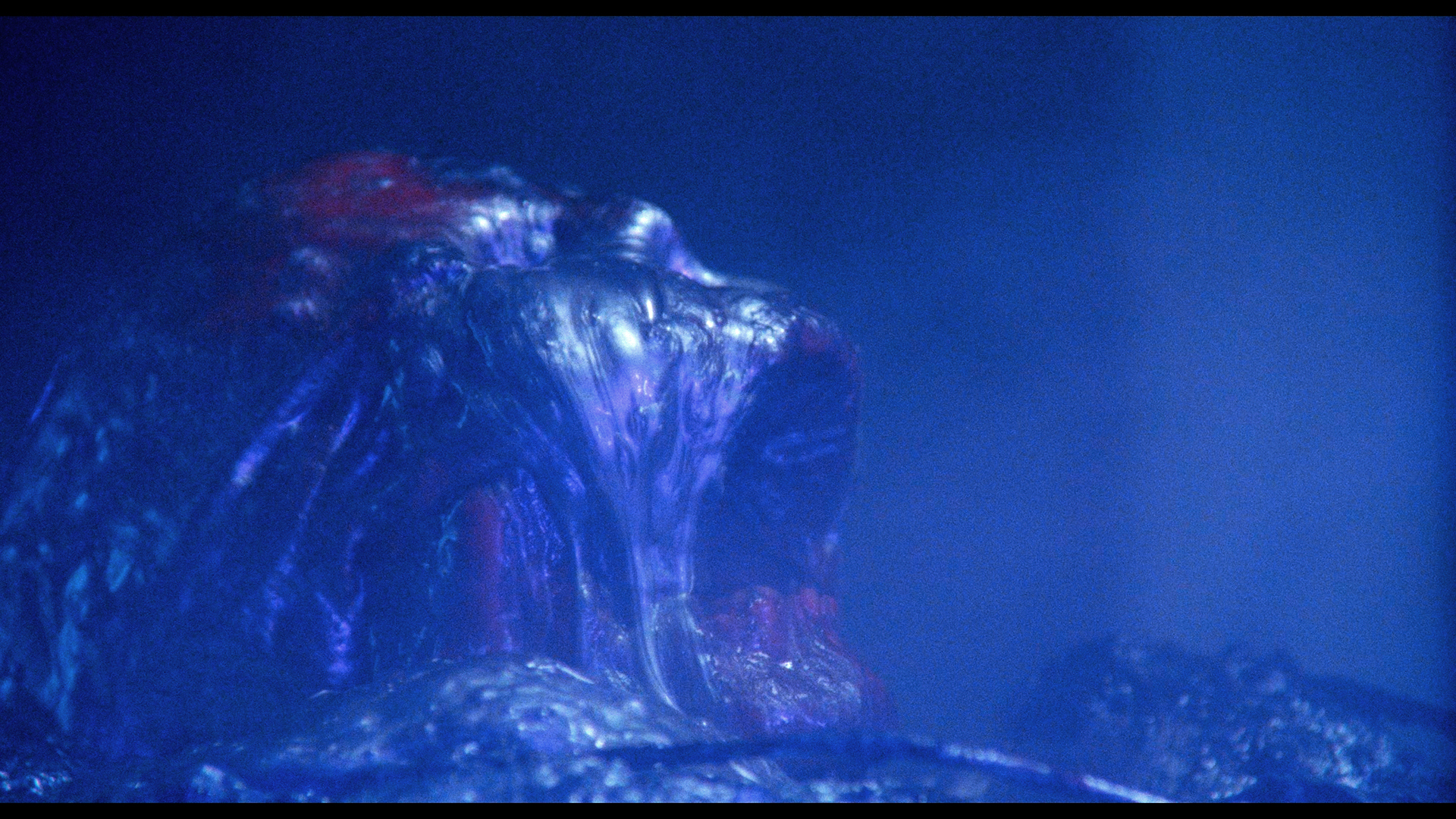
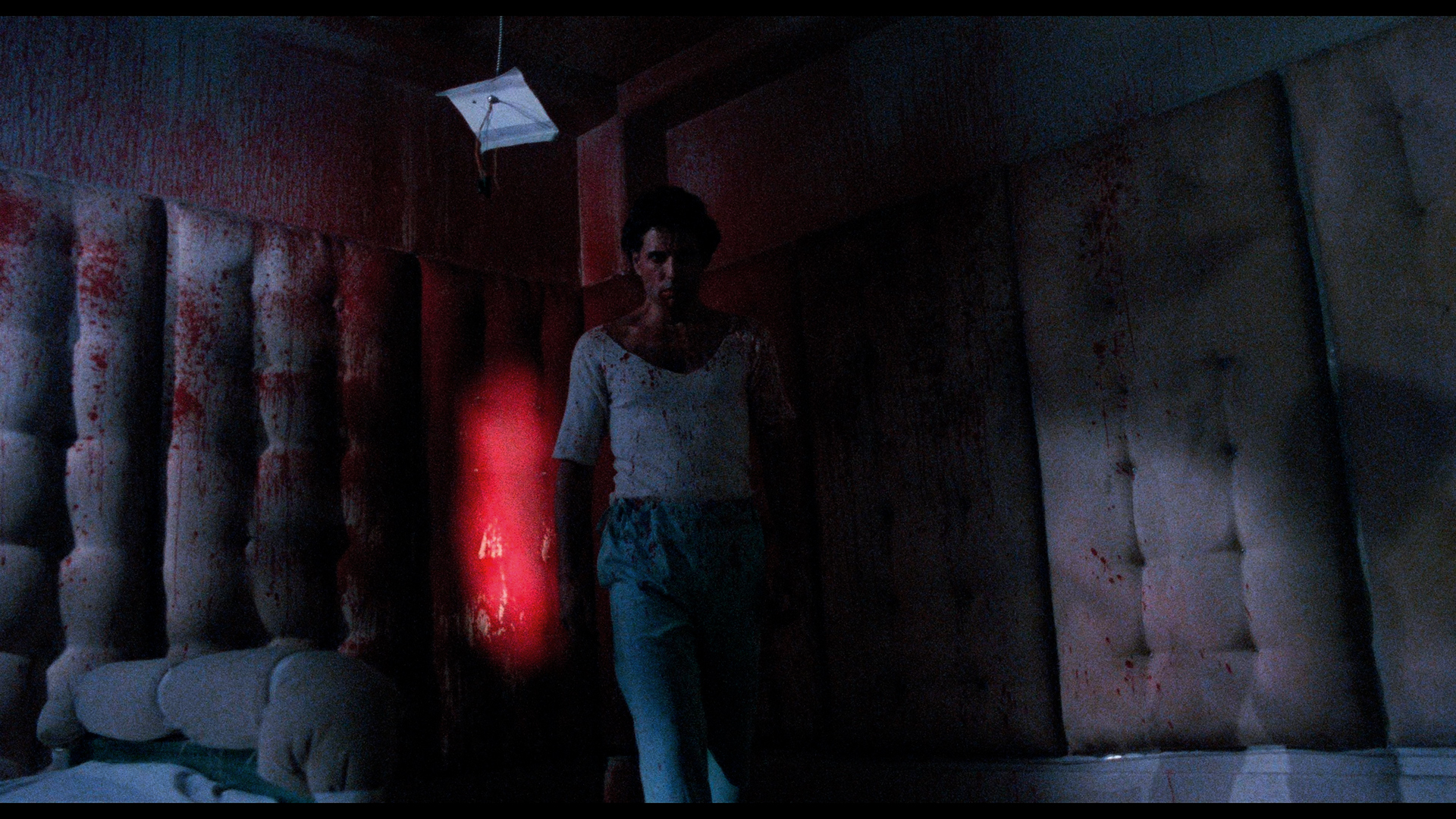
Scream Factory (Blu-ray)
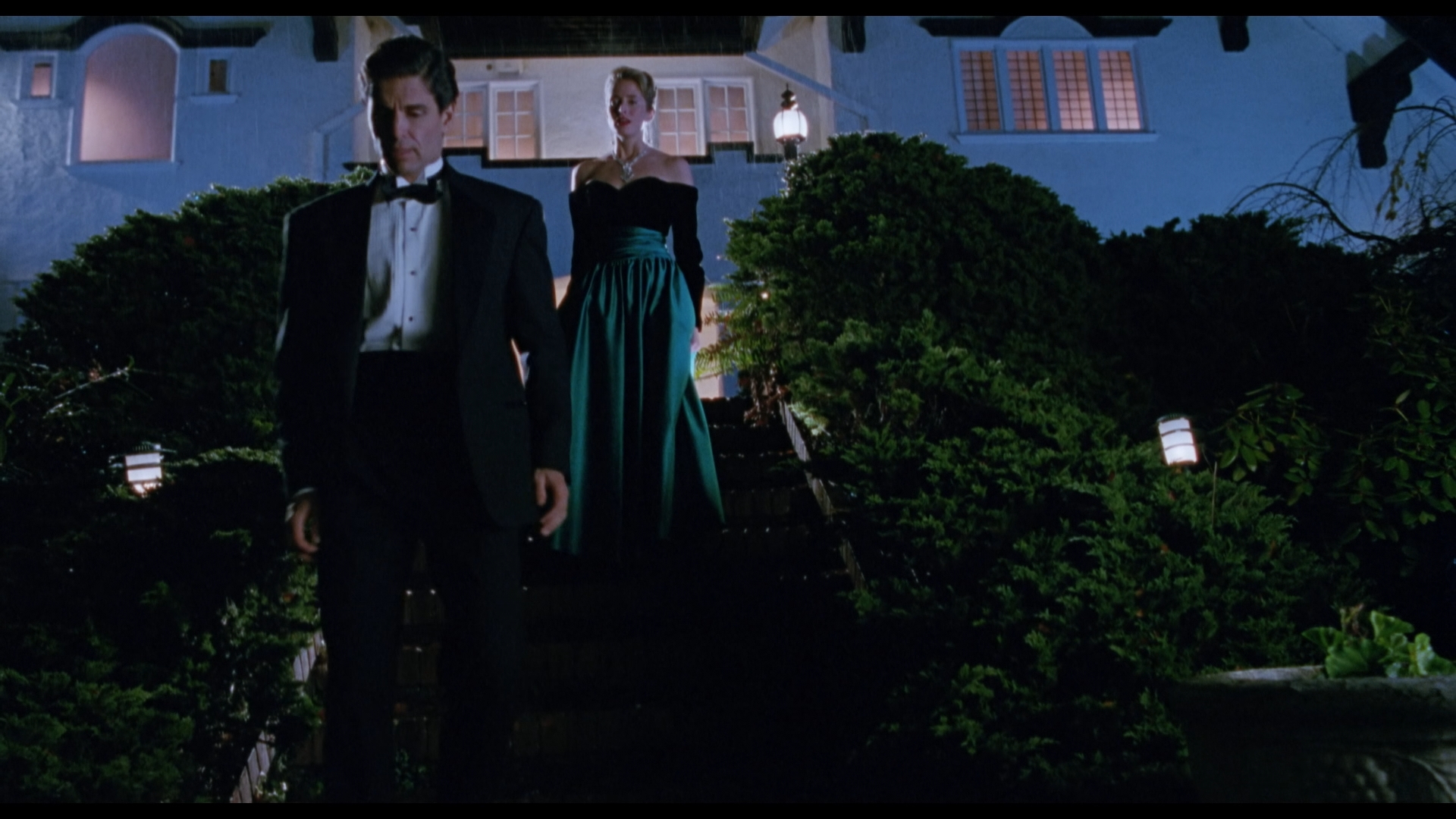
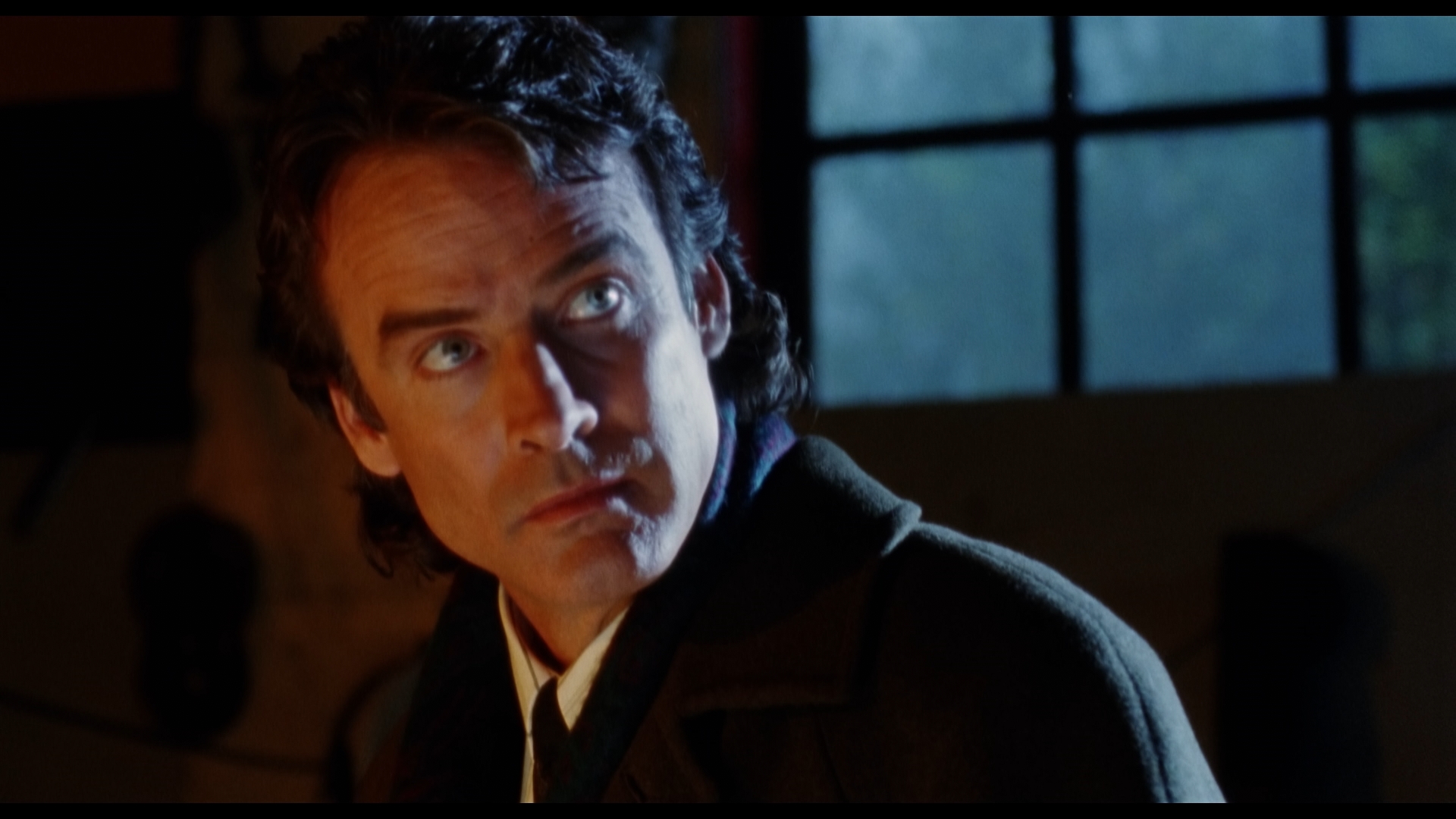
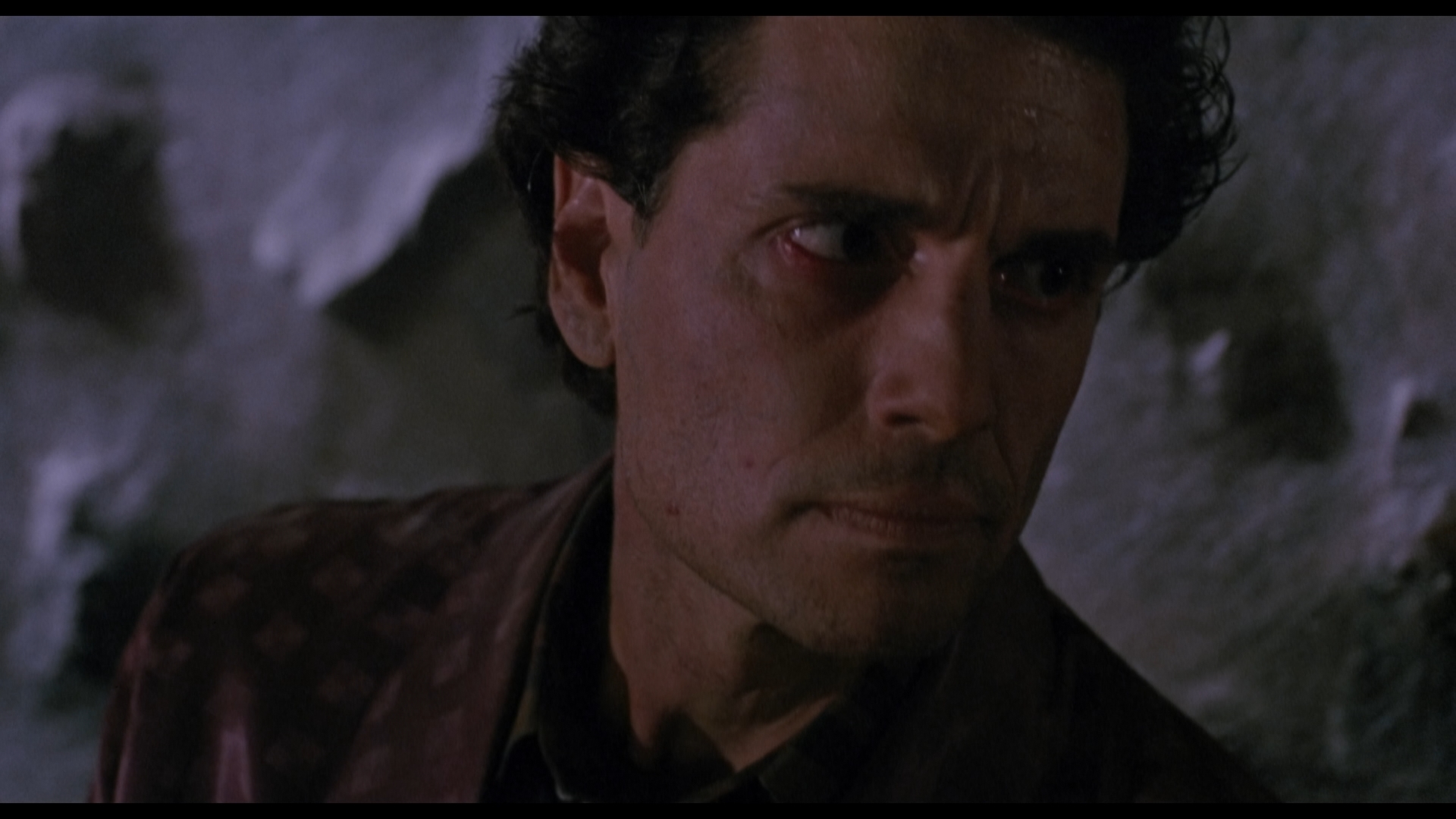
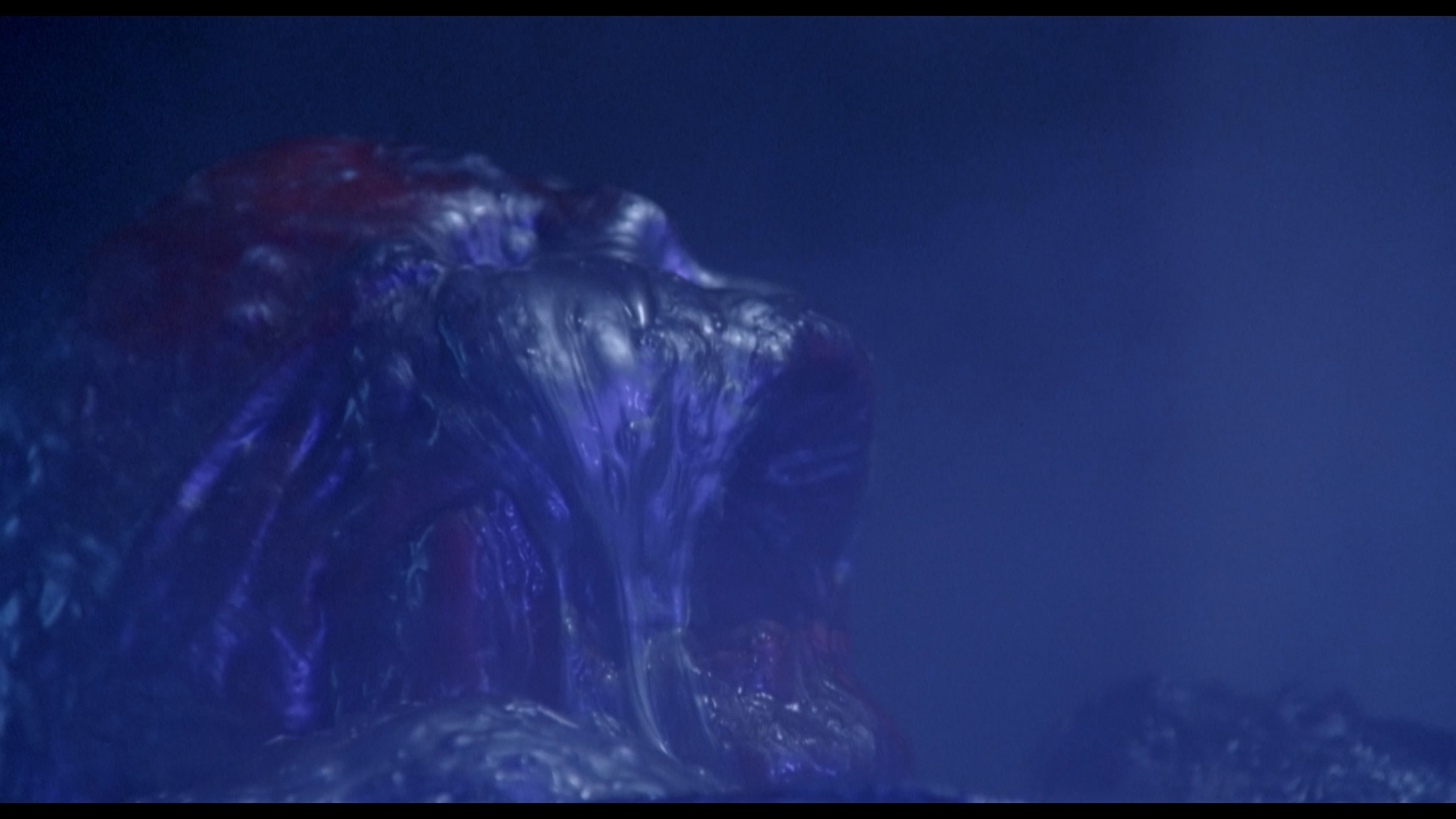
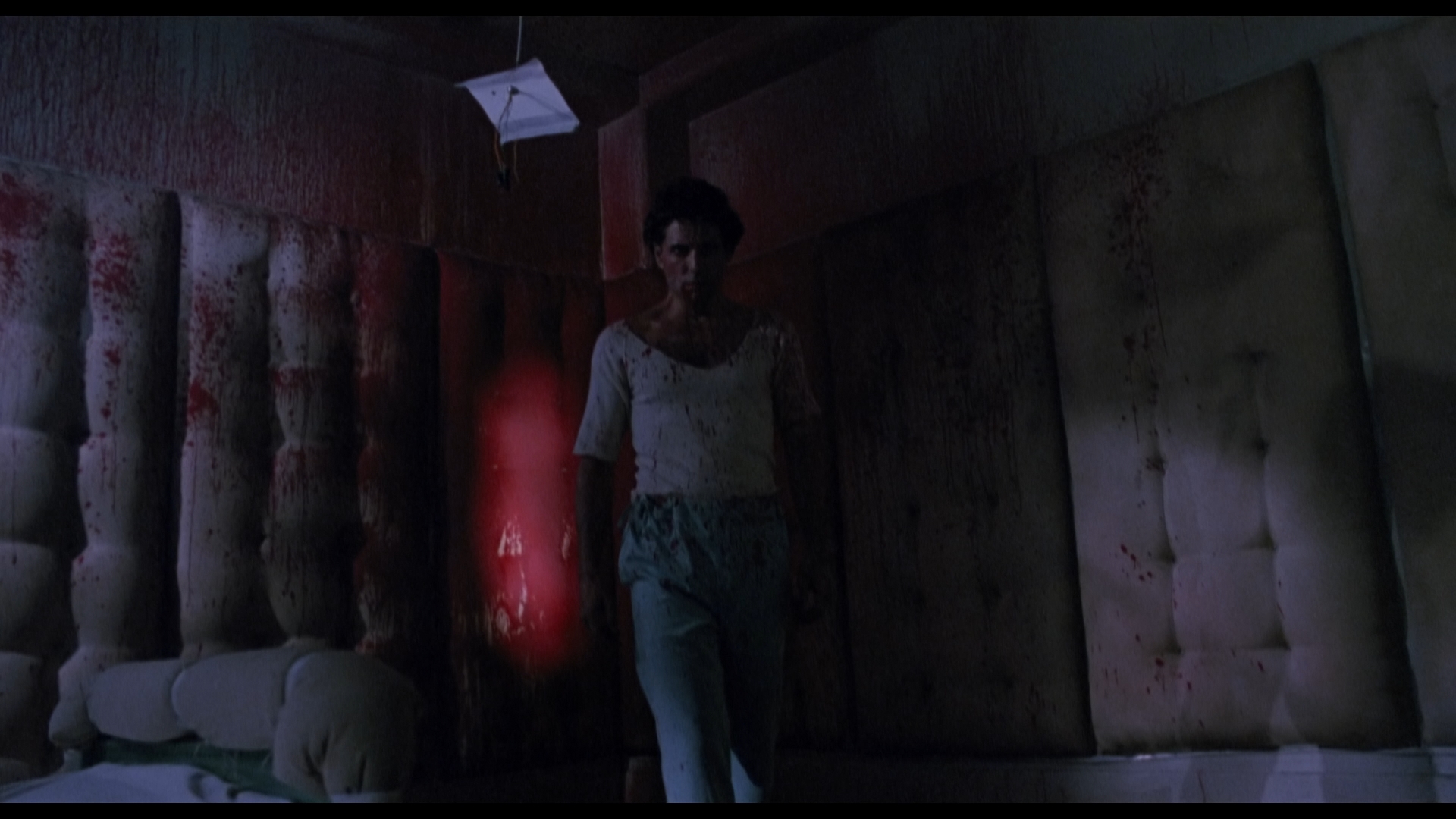
Updated review on October 10, 2025.





 second and final directorial effort for Dan O'Bannon
second and final directorial effort for Dan O'Bannon  (after The Return of the Living Dead) could have come at a worse time. The theatrical market for horror in the early '90s was imploding with the majority of worthy titles shuffling off straight to VHS instead, and even once-mighty genre titans like John Carpenter were stumbling as they tried to hop into other genres. However, O'Bannon (who also wrote Dark Star, Blue Thunder, and Alien) had just collaborated on the well-received Total Recall, and so the self-professed Lovecraft fan was allowed to direct a feature film version of the horror scribe's novella, The Case of Charles Dexter Ward, which had been earlier adapted very loosely by Roger Corman as The Haunted Palace with Vincent Price. O'Bannon had been trying to crack the story himself for years but instead turned to a script by Brent Friedman (Syngenor), who had come up with a clever way of modernizing the tale while remaining faithful to the original narrative.
(after The Return of the Living Dead) could have come at a worse time. The theatrical market for horror in the early '90s was imploding with the majority of worthy titles shuffling off straight to VHS instead, and even once-mighty genre titans like John Carpenter were stumbling as they tried to hop into other genres. However, O'Bannon (who also wrote Dark Star, Blue Thunder, and Alien) had just collaborated on the well-received Total Recall, and so the self-professed Lovecraft fan was allowed to direct a feature film version of the horror scribe's novella, The Case of Charles Dexter Ward, which had been earlier adapted very loosely by Roger Corman as The Haunted Palace with Vincent Price. O'Bannon had been trying to crack the story himself for years but instead turned to a script by Brent Friedman (Syngenor), who had come up with a clever way of modernizing the tale while remaining faithful to the original narrative.  film was still given an unceremonious haul direct to
film was still given an unceremonious haul direct to  VHS by Live Home Video which later absorbed into Artisan and then Lionsgate, who only released a lackluster, now-discontinued DVD from the same old tape master.
VHS by Live Home Video which later absorbed into Artisan and then Lionsgate, who only released a lackluster, now-discontinued DVD from the same old tape master.  down if they missed the
down if they missed the  first round on VHS.
first round on VHS.  whereas he dies for no apparent reason in the theatrical cut), but some other added scenes include a (wisely
whereas he dies for no apparent reason in the theatrical cut), but some other added scenes include a (wisely  jettisoned) romantic subplot for March and Mrs. Ward and a more gruesome dream sequence with some squishy stock footage of brain surgery. What's more interesting here is reflecting how some of the more inconsequential footage would have affected the pacing and tone of the film, with Terry's performance in particular making a little more sense as he has some deadpan comic bits with Lonnie and his secretary that clarify what he was going for here. As you'd probably expect, the quality of all this footage is pretty rough (with some missing effects shots and no music score), but it's great to have it included here.
jettisoned) romantic subplot for March and Mrs. Ward and a more gruesome dream sequence with some squishy stock footage of brain surgery. What's more interesting here is reflecting how some of the more inconsequential footage would have affected the pacing and tone of the film, with Terry's performance in particular making a little more sense as he has some deadpan comic bits with Lonnie and his secretary that clarify what he was going for here. As you'd probably expect, the quality of all this footage is pretty rough (with some missing effects shots and no music score), but it's great to have it included here.  the DVD also has a two-part dramatization of the original tale.
the DVD also has a two-part dramatization of the original tale. Factory brought the film back into circulation as a Blu-ray special edition that marked its first worthwhile stateside presentation. Surprisingly, it also featured a much newer and fresher-looking scan compared to the German Blu-ray with better detail and color; as usual the DTS-HD MA 2.0 English track sounds fine and features optional English SDH subtitles. Extras include the previous commentary track with Borde and company, the five Red Shirt featurettes, the deleted scenes, the Chainsaw Awards speech, the U.S. and Japanese trailers, and an 8m10s photo gallery. You also get two new featurettes starting with "Claire's Conundrum" (15m29s) with a very endearing Sibbett talking about her own trepidation when it comes to horror movies, her early acting career in TV, her thoughts on the film's enduring appeal, and the odd icebreaking moment she had with Terry for their first scene. In "The Strange Case of Charles Dexter Ward" (24m22s), author S.T. Joshi covers the essential themes of the story, the autobiographical elements Lovecraft incorporated, the role of Providence in the story, and the way the film translates the material in sometimes very clever ways.
Factory brought the film back into circulation as a Blu-ray special edition that marked its first worthwhile stateside presentation. Surprisingly, it also featured a much newer and fresher-looking scan compared to the German Blu-ray with better detail and color; as usual the DTS-HD MA 2.0 English track sounds fine and features optional English SDH subtitles. Extras include the previous commentary track with Borde and company, the five Red Shirt featurettes, the deleted scenes, the Chainsaw Awards speech, the U.S. and Japanese trailers, and an 8m10s photo gallery. You also get two new featurettes starting with "Claire's Conundrum" (15m29s) with a very endearing Sibbett talking about her own trepidation when it comes to horror movies, her early acting career in TV, her thoughts on the film's enduring appeal, and the odd icebreaking moment she had with Terry for their first scene. In "The Strange Case of Charles Dexter Ward" (24m22s), author S.T. Joshi covers the essential themes of the story, the autobiographical elements Lovecraft incorporated, the role of Providence in the story, and the way the film translates the material in sometimes very clever ways.![]()